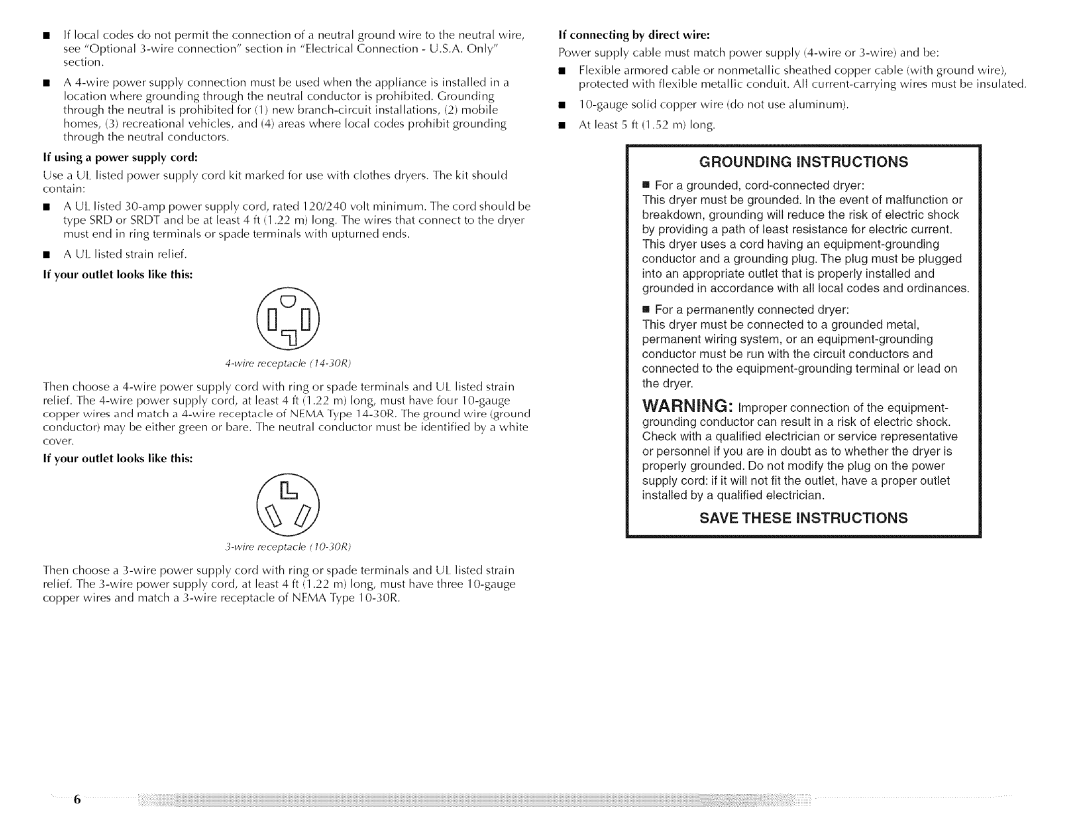Secheuse Electrique Avec Conduit Devacuation
W10088776A
Table of Contents Indice
Table DES Matieres
Dryer Safety
When the dryer is Used Near
Out Do not use
Vent clamps
Compound For installing
Installation Clearances
Caulking gun
110cm
Installation Requirements
Mobile Home Installations
5cm
If your outlet looks like this
If using a power supply cord
If connecting by direct wire
Wirrceptacl lO-30R
Do not use an extension cord
It is your responsibility
AB C D
If your Home has You will Go to Section Connecting to
Nema
Wire connection Power Supply Cord
Wire receptacle Nfma type 14-30R Prong plug
Shown
Wire connection Direct Wire
Neutral ground wire Fxternal ground conductor screw
Rigid metal vent
If using awl existing vent system
If this is a new vent system Vent material
Elbows
Recommended exhaust installations
10.2 cm
Louwred hood styli Box hood style
Determine vent path
Alternate installations for close clearances
Special provisions for mobile home installations
Vent
Length of flexible metal vent
Vent system chart 0 ft 0 m to 10 ft 3.0 m
No.
Check
U.S.A
Canada
How Automatic Drying Works
Dryer USE
Or fire
To stop your dryer
Rack Dry
Every Load Cleaning
Dryer Care
Temp Time
Moving care For power supply cord-connected dryers
For direct-wired dryers
As Needed Cleaning
From Inside the Dryer Cabinet
Troubleshooting
Use a heavy metal vent Do not use a plastic vent
Do not use a metal foil vent
Lint on load Is the lint screen clogged?
Is the dryer located in a closet?
Has an air dry cycle been selected?
Is the dryer being used for the first time?
If you need replacement parts
Maytag Corporation Major Appliance Warranty
Ii %iii!i
Page
Seguridad DE LA Secadora
Ii%iii!i!27
Nivel
Que
Tijeras para lata instalaciones Del nuevo ducto de escape
Abrazaderas para ducto
Espacios para la instalaci6n
Patas niveladoras
Piezas necesarias
27%
Ponerse en contacto con un instalador el6ctrico calificado
As instalaciones en casas rodantes necesitan
Conexi6n elctrica
Siempleauncable de suministro el6ctrico
Si el contacto de pared luce como 6ste
Cntacto de 3 alambrs f 10-30R
Incendio o choque electrico
Instale el protector de cables
IZI¸IZIL
Conector Del conducto Removible
Opciones para la conexi6n
Elctrica
ConductordetierraexternoAprieteeltornillo
£ Hilo neutlo diGpuesta a tiGna
Ld!Y
Peligro de Incendio
Si usa un sistema de ventilaci6n existente
10,2 cm
Ducto descape c/rnetal pesado c/4 10,2 crn
Ducto de escape de metal rigido
BienMdjor
De ventilaci6n
Flexible
Para espacios limitados Seleccione
Instalaciones
Pies 105 pies 90 pies 36,6 m 32,0 m 27,4 m
Devueltas
Del ducto
Peligro de Peso Excesivo
SJ,a¢, oY 6 , 5eaioa
USO DE LA Secadora
Ciclo de Aire
Estante
Para detener y volver a poner en marcha
Para volver a poner en marcha su secadora
Temp Tiempo
Limpieza de cada carga
Limpieza peri6dica
Del ducto de escape
Cuidado para las vacaciones
El temporizador no avanza notablemente
Solucion DE Problemas
La secadora no funciona
Demasiado largos, o la carga est demasiado caliente
Ropa arrugada
Pelusa en la ropa Est obstruido el filtro de pelusa?
EslJ la secadora ubicada en un armario?
Ayuda O Servicio Tecnico
Si necesita piezas de repuesto
Attn CAR Center
Garanta Limitada DE UN Aiio
Exclusion DE Garantas IMPLiCITAS Limitacin DE Recursos
Page
Securite DE LA Secheuse
Votre scurit et celle des autres est tres importante
Iorsque La secheuse
Secheuse Les Articles Contamines Par des
Incendie Ou une explosion Fabriques
Utiiisee
Instructions Dinstallation
Piices fournies
Iid de nivellement
Dimensions de la scheuse
Linstallation dans une maison mobile exige
Instructions DE Liaison a LA Terre
Cest Iutilisateur quincombe la responsabilit de
CZmduit dvacuation en mtal Iourd de 4 10,2 cm
Conduit mtallique flexible
BonMeilleur
Installations dvacuation recommandes
Rigide ou souple
Bride deserrage
Tableaux des systmes dvacuation
Autres installations o le dgagement est rduit
Dterminer Iitinraire dacheminement du conduit
Tableau
Du conduit Direction
Dvacuation mtallique
Nombre De change Ments de Direction
HaH
Si la scheuse ne dmarre pas, vrifier ce qui suit
Us ts, @
Fonctionnement du programme de schage automatique
Arrt et remise en marche
Entretien DE LA Secheuse
Nettoyage avant chaque charge
Nettoyage au besoin
Intrieur de la caisse de la scheuse
Precautions prendre avant un dmnagement
O1tHl
Iintrieur du conduit dvacuation
Ne pas utiliser un conduit devacuation en piastique
Ne pas utiliser un conduit devacuation en feuilie de metal
Charpie sur la charge
Taches sur la charge ou sur le tambour
Charges froiss6es
Assistance OU Service
Si vous avez besoin de pices de rechange
Pour plus dassistance
Garantie DES Gros Appareils Menagers Maytag Corporation
Garantie Limitce DE UN AN
W10088776A

